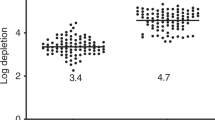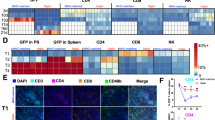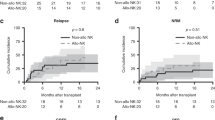Summary:
Exploiting the graft-versus-leukemia (GVL) effect in mismatched transplants requires its separation from graft-versus-host disease (GVHD). We generated leukemia-specific cytotoxic T lymphocytes (CTL) in three haplotype-mismatched, two class I-mismatched and two single HLA-A locus-matched stimulator–responder pairs. Six patients with chronic myelogenous leukemia and one patient with acute myeloid leukemia transformed from MDS were studied. CTL generated after 10 days stimulation with unselected leukemic peripheral blood mononuclear cells inhibited leukemic CFU-GM colony growth (>85% at 10:1 effector:target ratio) with no third-party colony inhibition. In five pairs, responders were cultured separately with leukemia cells, PHA-B or LCL from the stimulator. After 2–4 restimulations, the T cell repertoire was examined by flow analysis using Vβ-specific antibodies. Test cultures (but not controls) showed preferential expansion of 1–4 Vβ families either common to two or more stimulators or unique to a particular stimulator. Notably, we elicited leukemia-specific TCR Vβ expansions on four out of five occasions. In two pairs, responder cells selected for the appropriate leukemia-specific Vβ family were shown to have leukemia-specific cytotoxicity. These leukemia-restricted T-cells were CD8+ or CD4+ and CD25+ or CD57+. The results support the development of strategies to selectively deplete GVHD and conserve GVL reactivity in mismatched transplants.
This is a preview of subscription content, access via your institution
Access options
Subscribe to this journal
Receive 12 print issues and online access
$259.00 per year
only $21.58 per issue
Buy this article
- Purchase on SpringerLink
- Instant access to full article PDF
Prices may be subject to local taxes which are calculated during checkout



Similar content being viewed by others
References
Henslee-Downey PJ, Abhyankar SH, Parrish RS, Pati AR . Use of partially mismatched related donors extends access to allogeneic marrow transplant. Blood 1997; 89: 3864–3872.
Henslee-Downey P . Mismatched bone marrow transplantation. Curr Opin Oncol 1995; 7: 115–121.
Szydlo R, Goldman JM, Klein JP, Gale RP . Results of allogeneic bone marrow transplants for leukemia using donors other than HLA-identical siblings. J Clin Oncol 1997; 15: 1767–1777.
Sykes M, Sachs DH . Genetic analysis of the anti-leukemic effect of mixed allogeneic bone marrow transplantation. Transplant Proc 1989; 21: 3022–3024.
Aizawa S, Sado T . Graft-versus-leukemia effect in MHC compatible and- incompatible allogeneic bone marrow transplantation of radiation-induced, leukemia-bearing mice. Transplantation 1991; 52: 885–889.
Versa F, Tabilio A, Velardi A, Cunningham I . Treatment of high-risk acute leukemia with T-cell depleted stem cells from related donors with one fully mismatched HLA haplotype. N Engl J Med 1998; 339: 1186–1193.
Sykes M, Preffer F, MaAfee S, Saidman SL . Mixed lymphohaemopoietic chimerism and graft-versus-lymphoma effects after non-myeloablative therapy and HLA-mismatched bone-marrow transplantation. Lancet 1999; 353: 1755–1759.
Green A, Clarke E, Hunt L, Canterbury A . Children with acute lymphoblastic leukemia who receive T-cell-depleted HLA mismatched marrow allografts from unrelated donors have an increased incidence of primary graft failure but a similar overall transplant outcome. Blood 1999; 94: 2236–2246.
Mattsson J, Uzunel M, Remberger M, Tammik L . Poor immune reconstitution after four or five major HLA antigen mismatched T cell-depleted allogeneic and autologous stem cell transplantation. Clin Exp Immunol 2001; 123: 162–169.
Gaschet J, Trevino MA, Cherel M, Vivien R . HLA-target antigens and T-cell receptor diversity of activated T cells invading the skin during acute graft-versus-host disease. Blood 1996; 87: 2345–2353.
Keever-Taylor CA, Bredeson C, Loberiza FR, Casper JT . Analysis of risk factors for the development of GVHD after T cell-depleted allogeneic BMT: effect of HLA disparity, ABO incompatibility, and method of T-cell depletion. Biol Blood Marrow Transplant 2001; 7: 620–630.
Leung WH, Turner V, Richardson SL, Benaim E . Effect of HLA class I or class II incompatibility in pediatric marrow transplantation from unrelated and related donors. Hum Immunol 2001; 62: 399–407.
Bonnet D, Warren EH, Greenberg PD, Dick JE . CD8(+) minor histocompatibility antigen-specific cytotoxic T lymphocyte clones eliminate human acute myeloid leukemia stem cells. Proc Natl Acad Sci USA 1998; 96: 8639–8644.
Gao L, Bellantuono I, Elsasser A, Marley SB et al. Selective elimination of leukemic CD34(+) progenitor cells by cytotoxic T lymphocytes specific for WT1. Blood 2000; 95: 2198–2203.
Molldrem JJ, Lee PP, Wang C, Felio K . Evidence that specific T lymphocyte may participate in the elimination of chronic myelogenous leukemia. Nature Med 2000; 6: 1018–1023.
Norbury LC, Clark RE, Christmas SE . b3a2 BCR-ABL fusion peptides are targets for cytotoxic T cells in chronic myeloid leukemia. Br J Haematol 2000; 109: 616–621.
Spiro RC, DeMartino JL, Boto W, Lazarus H . Comparison of membrane proteins of Burkitt's lymphoma and EBV-transformed B lymphoblast cell lines and Con A-activated T lymphocytes and T lymphoblast cell lines. Leuk Res 1979; 3: 315–327.
Melenhorst JJ, Sorbara L, Kirby M, Hensel NF . Large granular lymphocyte leukemia is characterized by CD8+ lymphocyte populations. Br J Haematol 2000; 112: 189–194.
Molldrem JJ, Clave E, Jiang YZ, Mavroudis D . Cytotoxic T lymphocytes specific for a nonpolymorphic proteinase 3 peptide preferentially inhibit chronic myeloid leukemia colony-forming units. Blood 1997; 90: 2529–2534.
Hensel N, Agarwala V, Jiang YZ, Mavroudis D . A technique for dual determination of cytotoxic and helper lymphocyte precursor frequency by a miniaturized dye release method. Bone Marrow Transplant 1999; 23: 71–78.
Wang XM, Terasaki PI, Rankin GWJ, China D . A new microcellular cytotoxicity test based on Calcein AM release. Hum Immunol 1993; 37: 264–270.
Chen RL, Reynolds CP, Seeger RC . Neutrophils are cytotoxic and growth-inhibiting for neuroblastoma cells with an anti-GD2 antibody but, without cytotoxicity, can be growth-stimulating. Cancer Immunol Immunother 2000; 48: 603–612.
Sheehy ME, McDermott AB, Furlan SN, Klenerman P . A novel technique for the fluorometric assessment of T lymphocyte antigen specific lysis. J Immunol Methods 2001; 249: 99–110.
Currier JR, Deulofeut H, Barron KS, Kehn PJ . Mitogens, superantigens, and nominal antigens elicit distinctive patterns of TCRB CDR3 diversity. Hum Immunol 1996; 48: 39–51.
Germain RN . MHC-dependent antigen processing and peptide presentation: providing ligands for T lymphocyte activation. Cell 1994; 76: 287–299.
Young NT, Roelen DL, Wood K, Welsh KI . Primary alloreactive cytotoxic T-lymphocytes are not commonly restricted by self-HLA class I antigens. Hum Immunol 1996; 50: 38–46.
Sadovnikova E, Stauss HJ . Peptide-specific cytotoxic T lymphocytes restricted by nonself major histocompatibility complex class I molecules: reagents for tumor immunotherapy. Proc Natl Acad Sci USA 1996; 93: 13114–13118.
Sadovnikova E, Jopling LA, Soo KS, Stauss HJ . Generation of human tumor-reactive cytotoxic T cells against peptides presented by non-self HLA class I molecules. Eur J Immunol 1998; 28: 193–200.
Mutis T, Schrama E, van Luxemburg-Heijs SAP, Falkenburg JHF . HLA class II restricted T-cell reactivity to a developmentally regulated antigen shared by leukemic cells and CD34+ early progenitor cells. Blood 1997; 90: 1083–1090.
Mutis T, Verdijk R, Schrama E, Esdendam B . Feasibility of immunotherapy of relapsed leukemia with ex vivo -generated cytotoxic T lymphocytes specific for hematopoietic system-restricted minor histocompatibility antigens. Blood 1999; 93: 2336–2341.
Mutis T, Blokland E, Kester M, Schrama E . Generation of minor histocompatibility antigen HA-1-specific cytotoxic T cells restricted by nonself HLA molecules: a potential strategy to treat relapsed leukemia after HLA-mismatched stem cell transplantation. Blood 2002; 100: 547–552.
Andre-Schmutz I, Le Deist F, Hacein-Bey-Abina S, Vitetta E . Immune reconstitution without graft-versus-host disease after haemopoietic stem-cell transplantation: a phase 1/2 study. Lancet 2002; 360: 130–137.
Montagna D, Yvon E, Calcaterra V, Comoli P . Depletion of alloreactive T cells by a specific anti-interleukin-2 receptor p55 chain immunotoxin does not impair in vitro antileukemia and antiviral activity. Blood 1999; 93: 3550–3557.
Mavroudis DA, Dermime S, Molldrem J, Jiang YZ . Specific depletion of alloreactive T cells in HLA- identical siblings: a method for separating graft-versus-host and graft-versus-leukemia reactions. Br J Haematol 1998; 101: 565–570.
Falkenburg JH, Wafelman AR, Joosten P, Smit WM . Complete remission of accelerated phase chronic myeloid leukemia by treatment with leukemia-reactive cytotoxic T lymphocytes. Blood 1999; 94: 1201–1208.
Lowdell MW, Lamb L, Hoyle C, Velardi A . Non-MHC-restricted cytotoxic cells: their roles in the control and treatment of leukemias. Br J Haematol 2001; 114: 11–24.
Author information
Authors and Affiliations
Rights and permissions
About this article
Cite this article
Fujiwara, H., Sconocchia, G., Melenhorst, J. et al. Tissue-restricted T cell alloresponses across HLA barriers: selection and identification of leukemia-restricted CTL in HLA-mismatched stimulator–responder pairs. Bone Marrow Transplant 32, 371–378 (2003). https://doi.org/10.1038/sj.bmt.1704142
Received:
Accepted:
Published:
Issue date:
DOI: https://doi.org/10.1038/sj.bmt.1704142



